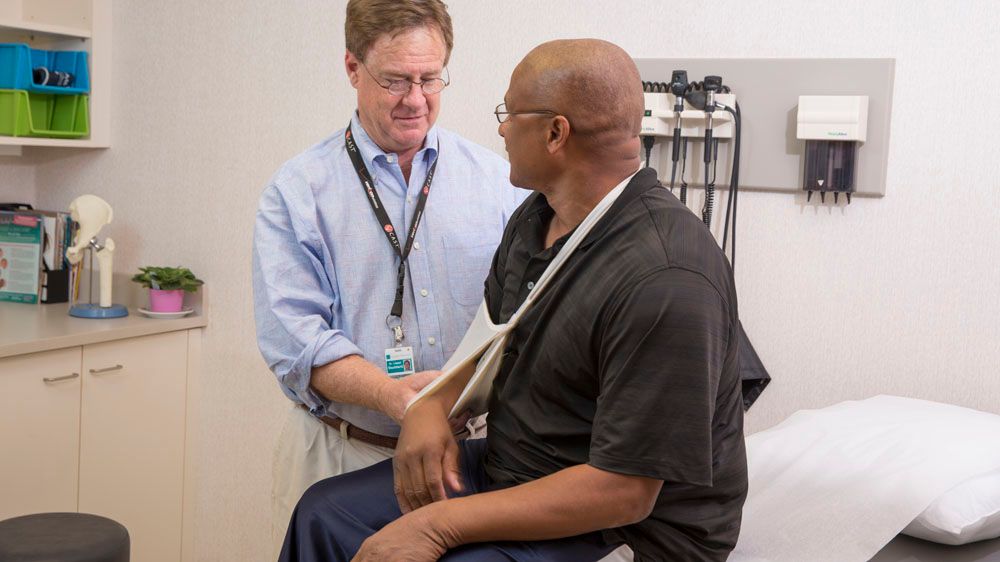Elbow Pain: Causes and Treatments
Left untreated, a sore elbow can diminish your quality of life. The orthopedic specialists at Beaufort Memorial can help you get to the root of elbow pain and find a nonsurgical or surgical treatment that can restore function and reduce its impact on your daily life.
Experiencing elbow pain? Request an appointment with an orthopedic surgeon, or call 843-522-7435 to discuss your symptoms.

What Causes Elbow Pain?
Arthritis
Arthritis affects joints throughout the body, causing inflammation that leads to pain and swelling. Osteoarthritis, caused by wear and tear on the joints, is the most common type of arthritis. It can lead to pain or a clicking sensation around the elbow.
However, two other types of arthritis, rheumatoid arthritis and psoriatic arthritis, can also cause elbow pain. In rheumatoid arthritis, the immune system mistakenly attacks the joints. With psoriatic arthritis, elbow pain caused by inflammation in the tendons is accompanied by a skin condition called psoriasis.
Gout, a buildup of uric acid in the blood, is another type of arthritis that can cause pain and swelling in the elbows. With gout, skin may appear red and shiny.
Tendonitis
Tendonitis occurs when tendons that experience excessive force or overuse become inflamed or damaged.
Two common forms include tennis elbow (lateral epicondylitis), in which pain is felt outside the elbow, and golfer’s elbow (medial epicondylitis), in which pain is felt inside the elbow. Although both conditions may begin with pain in the elbow, pain can radiate into the upper arm, forearm and hand, causing a weak grip.
Bursitis
Bursitis is a condition in which small fluid-filled sacs called bursae become irritated or inflamed. Often, the condition develops when people perform repetitive motions or put a lot of pressure on their elbows, for example, leaning on a table or working in positions that put strain on the elbows. Bursitis can also develop when an infection or injury causes the bursae to swell. The condition is associated with rheumatoid arthritis and diabetes.
Cubital and Radial Tunnel Syndromes
In cubital tunnel syndrome, the ulnar nerve, which runs from the neck to the hand, gets compressed or irritated where it runs along the inside of the elbow. It can develop as a result of arthritis or from a previous elbow fracture. Generally, cubital tunnel syndrome causes numbness and tingling in the hands and fingers, rather than the elbow. You may notice that numbness or tingling if you’ve bent your elbow for a long time, such as when you’re sleeping.
A similar but much less common condition called radial tunnel syndrome occurs when the radial nerve, which runs from the armpit to the hand along the outside of the arm, gets compressed. Radial tunnel syndrome often causes pain in the forearm, but it can mimic symptoms of tennis elbow.
Treatment Options
The experienced orthopedic specialists at Beaufort Memorial have helped many individuals with injuries and pain caused by overuse or arthritic conditions.
Generally, they recommend conservative treatments first. These can include:
- Bracing to minimize joint movements
- Corticosteroid injections to alleviate inflammation
- Rest, ice, compression and elevation to reduce pain caused by overuse
- Physical therapy and rehabilitation to reduce pain and improve range of motion
When necessary, an orthopedic surgeon may recommend one of the following minimally invasive surgical procedures:
- Arthroscopic surgery: Orthopedic surgeons use a small camera to diagnose and sometimes assist with treating inflammatory conditions, such as arthritis and tendonitis.
- Tendon/ligament repair: Surgeons can perform procedures to repair tendons and ligaments damaged by tendonitis.
